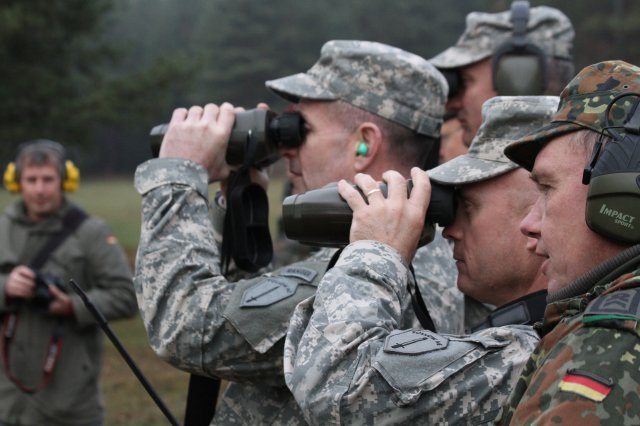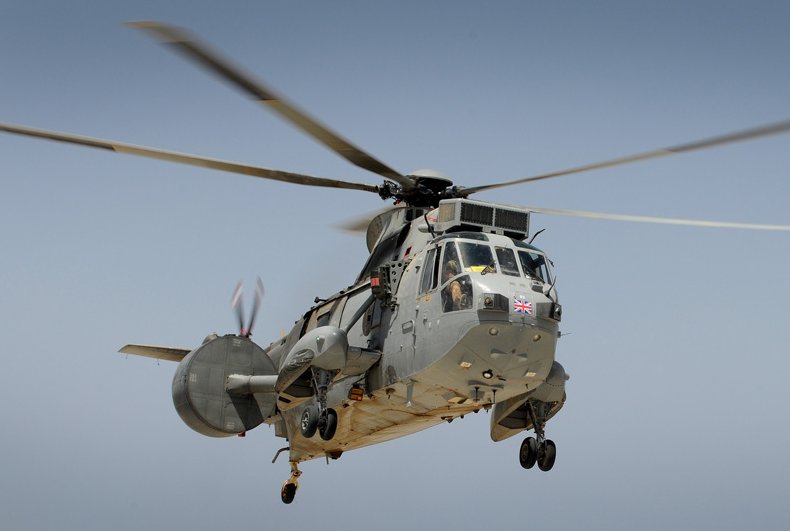No matter which country’s uniform Soldiers wear, the challenges they face and the triumphs they enjoy are often the same. Long hours spent in formation. Weeks spent in training, listening intently to learn about the dangers they’ll face in war. The nerves of standing at attention while a First Sergeant looks them over. The pride of getting pinned with an award by a commander.
So the bonds were formed quickly and deeply between young enlisted Soldiers from both the U.S. and Germany at a recent sniper course held here at the German Army’s Infantry School. Troops from the Bundeswehr and USAG Bamberg’s 42nd Route Clearance Company, 54th Engineer Battalion, 18th Engineer Brigade took part in the three-week school.
“These guys were so helpful,” said Pvt. 1st Class Chris Alston, about his Bundeswehr companions. “They showed us around. They took us to a great German restaurant. Sometimes even when they couldn’t think of the English word for something they’d go out of their way to find the right way to talk to us.”
Alston was joined in the training by fellow U.S. Army Spcs. Joseph Teresi, Dustin Eudy and Matthew Lambert. The four of them agreed that the training was like nothing they’d encountered before in the Army.
But the friendship didn’t only run between the young participants. At all levels of leadership, cooperation is rampant between the two nations.
“This is all great stuff,” said Maj. Larry Caswell, of the 18th Engineer Brigade. “It makes sense that the guys should be training like this. This is how we deploy, anyway. It’s all about multinational cooperation.”
Caswell came to award the Soldiers from his brigade the Schützenschnur, or German Marksmanship Badge, that they had earned over the course. But last-minute guests pleasantly derailed Caswell’s plans.
On the day of the young Soldiers’ graduation, Maj. Gen Robert Brown, commander of Ft. Benning’s Maneuver Center of Excellence joined Col. Walter Piatt and Command Sgt. Maj Steven McCaflin, the command team of Ft. Benning’s hallowed Infantry School in touring Hammelburg, the German Bundeswehr’s primary infantry training location.
For the young Engineers, receiving awards of achievement from a foreign army is a huge accomplishment in itself. But to be awarded by a two-star general proved a rare treat indeed. The Soldiers snapped to rigid attention, and repeatedly answered Brown with a clipped, enthusiastic “hooah, sir.”
“Hopefully this training will help you guys a whole bunch,” said Brown as he handed the distinctive silver cable bearing a gold medallion to the Soldiers with a friendly smile and an encouraging clap on the shoulder. “We’re proud of what you’ve done here.”
When Capt. William Murray, the company commander of the 42nd Route Clearance Co., told Brown about Spc. Dustin Eudy’s unique excellence among the class of sharpshooters, the general, a career-long infantry officer, was quick to realize the importance of Eudy, who is currently classed as an engineer.
“Eudy was so good at shooting, that when he gets back from his deployment,” said Murray with a chuckle, “we’ve got to look into a re-class.”
But the cross-training isn’t just one-way. Every year, the Bundeswehr sends some of their troops to Ft. Benning’s infantry and sniper schools, and U.S. Army instructors regularly travel to Germany to train Bundeswehr soldiers. But McCaflin, the senior enlisted leader of Ft. Benning’s Infantry School, stayed true to the ‘drive-on’ mentality so characteristic of command sergeants major.
“We need to keep doing more of this type of training,” said McCaflin as he shook the young Soldiers’ hands. “Well done.”
Hauptmann (equivalent to U.S. Army Capt.) Falko Reisser guided Brown, Piatt and McCaflin through Hammelburg. Reisser is a charismatic officer, effortlessly bilingual and highly-knowledgeable about the Infantry School and the sniper course in particular. After the U.S. Soldiers got their decorations, Reisser displayed the Bundeswehr’s most expert marksmen for the visiting commanders.
“These are our most qualified snipers,” he said to Brown, Piatt and McCaflin as they watched intently through binoculars at the snipers firing across a valley. Shots echoed off the rainy hills, and the German marksmen moved methodically, showing poise in the face of difficulty.
“They might not look it, but they’re actually very nervous,” said Stabsfeldwebel (equivalent to U.S. Army Master Sgt.) Markus Eckert, a senior instructor for the sniper course. “But it’s not because of the two-star. They don’t even know who he is.”
A German Army chief-of-staff was also in attendance, and he alone instilled fear and order within the German Soldiers.
After the awards ceremony and sniper display, leaders from both countries retreated to an officer’s club for lunch. The young officers traded deployment stories and realized some of them had ended up in the same locations in Iraq and Afghanistan over the years.
Reisser remembered sitting in a foxhole in Afghanistan on New Year’s Day and receiving a visit from now-retired Gen. Stanley McChrystal. The German chief-of-staff that so frightened the young Bundeswehr Soldiers pulled up a chair to talk to Murray. The Bundeswehr contains no route clearance units, and knowing that more cooperative work was in the future, Murray’s advice as a route clearance commander was invaluable to the senior German officer.
Whether at the lowest level of enlisted-Soldier training or big-picture command decisions, the U.S. Army and German Bundeswehr’s remain intertwined, much to the benefit and satisfaction of both parties.











